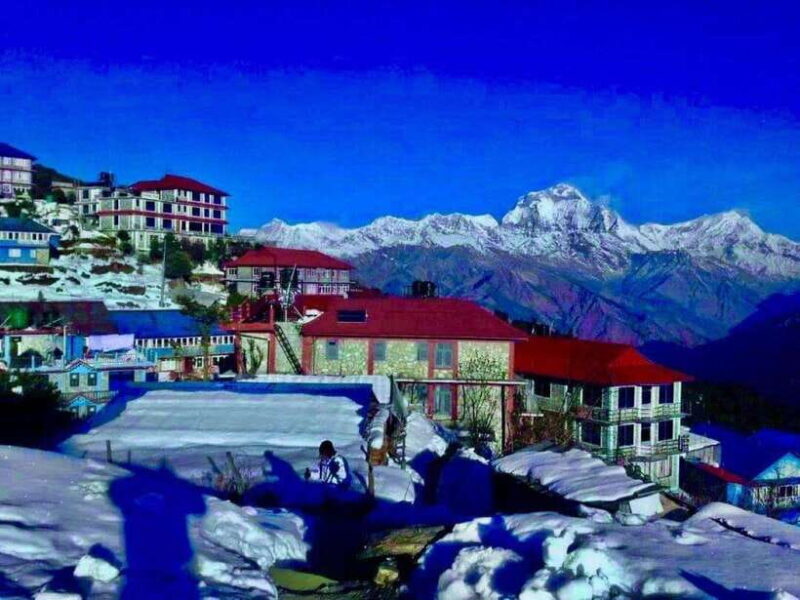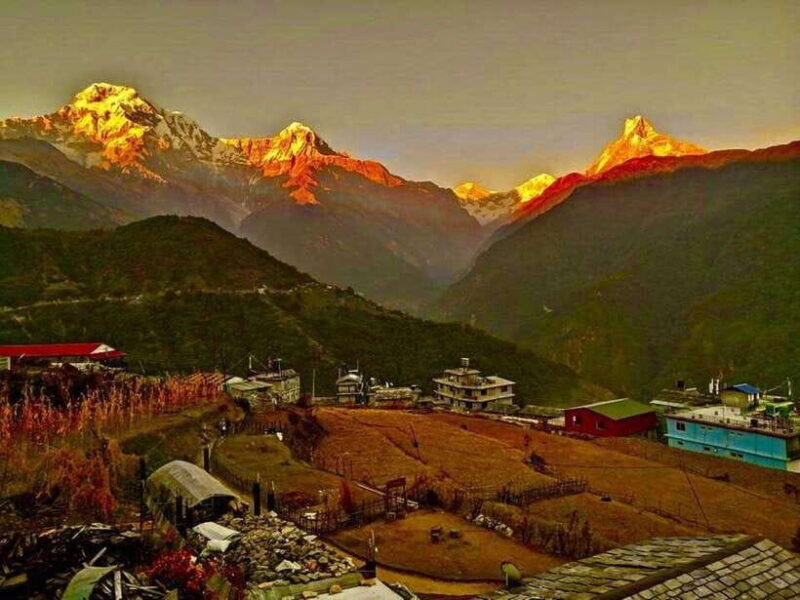Starting from the bustling streets of Kathmandu, this 6-day guided trek takes you straight into the heart of the Annapurna region. Priced at $305 per person, it offers a balanced mix of cultural discovery, scenic beauty, and accessible adventure. You’ll travel by bus, hike through lush forests and traditional villages, and wake up early to witness some of the most breathtaking mountain vistas Nepal has to offer.
Two things we particularly appreciate about this experience are the expert guiding and the chance to see the Himalayas without having to push yourself into high-altitude danger. The guide, typically a licensed Nepalese professional, isn’t just there to lead but to enrich your understanding of local customs, flora, and fauna. On the flip side, one consideration is the relatively long bus ride from Kathmandu to Pokhara, which takes about 8 hours — not ideal if you’re sensitive to long travel days.
This trek suits travelers who want a taste of Himalayan grandeur without the intense physical demands of a longer expedition. It’s ideal for those who enjoy cultural interactions, scenic walks, and panoramic mountain views, all wrapped into a manageable itinerary.
Key Points

- Accessible yet scenic: A relatively easy trek that still offers spectacular mountain vistas.
- Cultural immersion: Encounter diverse ethnic villages and learn about local traditions.
- Guided experience: Knowledgeable Nepalese guides enhance your understanding and safety.
- Flexible options: Small group size (limited to 15) means personalized attention.
- Value for money: Price includes transportation, guide, entrance fees, and accommodations.
- Breathtaking views: Panoramic scenes of peaks like Annapurna, Dhaulagiri, and Machhapuchhre.
An In-Depth Look at the Trek Experience

Love the outdoors? Here are other hiking experiences we've covered in Kathmandu
Starting in Kathmandu and Journeying to Pokhara
The adventure begins with an approximately 8-hour bus ride from Kathmandu to Pokhara, a city famed for its serene lake and mountain views. This long but comfortable journey includes tea and lunch stops, giving you a chance to stretch your legs and soak in Nepalese landscapes. Upon arrival, you’ll transfer to your hotel for the night, with the evening free to explore Fewa Lake and absorb the calm scenery away from Kathmandu’s hustle.
While some travelers find the bus ride a bit lengthy, it’s a small price for the scenery and the opportunity to transition smoothly into the mountain countryside. The ride is also part of the experience, offering glimpses of terraced fields, rivers, and villages that hint at what’s to come.
Day 1: Kathmandu to Ulleri via Nayapul
The next morning, you’ll transfer to Nayapul, the starting point for most trekking adventures in this region, by taxi and bus. The approximately 1.5-hour ride deposits you at 1000 meters elevation. From there, it’s a 5-6 hour trek to Ulleri, passing through lush forests, terraced fields, and traditional villages.
Ulleri is a charming mountain village known for its stone-paved streets and welcoming atmosphere. The climb is manageable but offers a taste of the terrain you’ll encounter on subsequent days. This first hike is a good introduction, with plenty of opportunities to enjoy the scenery and chat with locals and fellow trekkers.
Day 2: Ulleri to Ghorepani
Today’s highlight is the trek to Ghorepani, at 2800 meters. The walk takes about 5 hours and gradually gains elevation, with a landscape dotted with rhododendron forests (if you’re lucky, you’ll see blossoms). The trail is well-used but not overly difficult, making it suitable for most hikers.
Ghorepani is a bustling little village that serves as a hub for trekkers heading to Poon Hill. It’s lively in the evenings, with guesthouses and small restaurants. Here, you’ll appreciate the chance to rest and prepare for the early morning excursion the next day.
More Great Tours NearbyDay 3: Sunrise at Poon Hill and Trek to Tadapani
An early start (around 4:30 a.m.) for the spectacular Poon Hill sunrise is well worth it. The ascent takes about two hours in the dark, but the reward is a panoramic view of the Himalayas, including peaks like Annapurna, Dhaulagiri, and Machhapuchhre. The scene at dawn—mountains glowing in the first light—is unforgettable and often described as “the highlight” of many reviews.
After breakfast, the trek continues to Tadapani, a peaceful village amid forests, where you’ll spend the night. The day’s walk takes 6-7 hours, passing through rhododendron and pine forests. Many travelers comment on the peaceful atmosphere here, and nature lovers will enjoy the variety of flora and fauna along the trail.
Appreciate having local insight? Here are other guided experiences in Kathmandu we've examined
- Best of Kathmandu : Private Guide, Car & Personalized Tour
- From Kathmandu: Lower Manaslu Guided 8-Day Trek
- 14-Day Gokyo Lakes Trek with Guide
- Kathmandu: 4/7 UNESCO Heritage tour with Local Woman Guide
- From Kathmandu: 14-Day Manaslu Circuit Trek with Guide
- Kathmandu: Thamel and Asan Rickshaw Tour With Guide
Day 4: Tadapani to Ghandruk, then back to Pokhara
Today, the trek is shorter—about 3-4 hours to Ghandruk, a traditional Gurung village famous for its preserved architecture and welcoming locals. Visitors often mention the “amazing cultural exposure” here, as it offers a real glimpse into Nepalese mountain life.
After exploring Ghandruk, you’ll descend back towards Nayapul and take a bus to Pokhara, arriving in the evening. The last night in Pokhara is a good chance to relax by Fewa Lake and reflect on your journey.
Day 5: Return to Kathmandu
The final day involves a bus ride back to Kathmandu, which takes approximately 7-8 hours. While long, it’s a chance to see more of Nepal’s countryside and small towns, plus discuss your trek with fellow travelers or your guide.
What Makes This Trek Unique

Authentic Cultural Encounters: Unlike some treks that focus solely on scenery, this route offers encounters with diverse ethnic groups like Gurung and Magar people, whose villages and traditions remain largely untouched by modernity. Many reviews praise guides like Manoj or Rajesh for their extensive knowledge of local customs and stories, making the cultural side enriching rather than superficial.
Spectacular Mountain Views: The sweep of peaks like Annapurna, Dhaulagiri, and Machhapuchhre is breathtaking. The early morning Poon Hill sunrise is a universally praised moment, offering an almost surreal experience of the Himalayas.
Accessible Adventure: The trek’s relatively moderate difficulty, combined with excellent logistical support (transportation, accommodations, and a responsible guide), makes it appealing for those new to trekking or those who want a manageable challenge with high rewards.
What to Expect from the Guide
The guide plays a critical role, not just in navigation but in sharing insights about the landscape, flora, fauna, and local traditions. Their presence ensures safety and enhances the cultural experience, making the trek more meaningful. Many travelers mention the guides’ helpfulness and friendliness as a key part of the journey.
Practical Details and Pricing Analysis

Priced at $305, this tour covers most essentials: bus transportation from Kathmandu to Pokhara and back, hotel stays in Pokhara, entrance fees for Poon Hill, the guide’s salary, and necessary permits like the Trekking Information Management System (TIMS) and the Annapurna Conservation Area entry ticket.
The value here is significant considering the inclusions—transport, guiding, and some accommodations—are often the bulk of costs in trekking trips. You’re also getting a chance to see the Himalayan range with minimal hassle, which is worth the price for many travelers.
Note that meals during the trek, personal expenses, gear, and optional extras like porters are not included, so budget accordingly. The tour is designed for those who want a structured, guided experience without the unpredictability of independent planning.
Transportation and Duration
The long bus rides are part of the experience, but they might be tiring, especially for travelers prone to motion sickness. The trek itself involves mostly walking on well-maintained trails, with no significant altitude risk, making it suitable for most active travelers.
Who Should Consider This Trek?

This tour is perfect for first-time trekkers, cultural enthusiasts, and anyone wanting a safe, guided introduction to Nepal’s mountain scenery. It’s ideal for travelers who value authentic local encounters and want to enjoy spectacular mountain panoramas without extreme exertion or high-altitude risks.
If you’re short on time but want a meaningful Himalayan experience, this trek offers an excellent combination of scenic beauty, cultural exposure, and comfort.
The Sum Up

This guided trek to Poon Hill from Kathmandu through Pokhara offers a balanced mix of scenic majesty, cultural depth, and logistical simplicity. The well-organized itinerary, led by knowledgeable guides, ensures you get the most out of every step, with ample opportunities to enjoy mountain vistas and meet local communities.
You’ll appreciate the comfortable accommodations in Pokhara, the early morning viewings from Poon Hill, and the chance to learn about Nepalese culture firsthand. The moderate challenge makes it accessible to most healthy travelers, and the value for money is compelling given the inclusions.
If you’re looking for an authentic taste of Nepal’s Himalayas without the need for extreme trekking experience, this tour is an excellent choice. It will leave you with unforgettable memories of towering peaks, friendly villagers, and the vibrant life of the mountains.
FAQs
Is this trek suitable for beginners?
Yes, the trek is described as manageable and not very difficult, making it ideal for those new to trekking who want to experience the Himalayas.
How long is the bus ride from Kathmandu to Pokhara?
It takes about 8 hours, with stops for tea and lunch, so it’s a long journey but part of the adventure.
What’s included in the price?
Transportation (Kathmandu-Pokhara round trip, local transfers), 2 nights hotel in Pokhara, guide services, entrance tickets to Poon Hill, and permits like TIMS and Annapurna Conservation Area.
Are meals provided during the trek?
No, meals during the trek are not included, so you’ll need to budget for food, which is available at lodges along the trail.
What should I pack?
Bring comfortable hiking shoes, warm clothing, sun protection, a water bottle, camera, rain gear, and a sleeping bag if you have one. A detailed gear list is provided upon request.
Is there much altitude gain?
No, the highest point is Poon Hill at 3,210 meters, which is manageable for most healthy travelers.
Can I customize this tour?
While the itinerary is fixed, some extra services like porters or additional nights can often be arranged upon request.
This guided trek to Poon Hill balances comfort, adventure, and cultural richness—an ideal introduction to Nepal’s Himalayas. Whether you’re a first-timer or simply seeking a scenic escape, it promises memorable vistas and warm local hospitality, all within a well-organized framework.
You can check availability for your dates here:More Hiking & Trekking Tours in Kathmandu
More Guided Tours in Kathmandu
More Tour Reviews in Kathmandu
More Kathmandu experiences we've covered
- Full Day Private Bird-watching Tour in Phulchoki
- Everest Base Camp Trek
- Private Guided Half Day Tour to Jamchen and Kapan Monastery
- Combination of Nature, Culture and Heritage
- Annapurna Base Camp Trek
- Handmade Jewellery Workshop with Nepali Women
- Temples and Stupas Tour in Kathmandu Valley
- Pashupatinath Aarati Trip from Kathmandu
- 2 Days Ghorepani Poonhill Trek from Pokhara
- Explore Entire Kathmandu with Guide
- 3 Nights 4 Days Chitwan National Park with Tower Night Stay
- Pashupatinath Temple Aarti Night Tour
